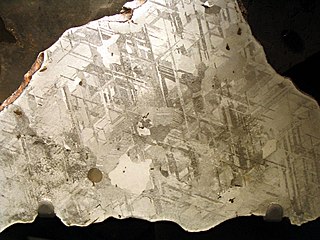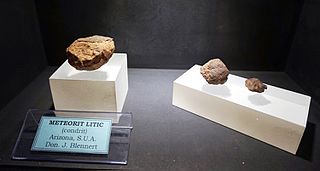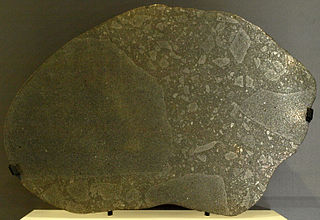Related Research Articles

Kamacite is an alloy of iron and nickel, which is found on Earth only in meteorites. According to the International Mineralogical Association (IMA) it is considered a proper nickel-rich variety of the mineral native iron. The proportion iron:nickel is between 90%:10% and 95%:5%; small quantities of other elements, such as cobalt or carbon may also be present. The mineral has a metallic luster, is gray and has no clear cleavage although its crystal structure is isometric-hexoctahedral. Its density is about 8 g/cm3 and its hardness is 4 on the Mohs scale. It is also sometimes called balkeneisen.

In meteoritics, a meteorite classification system attempts to group similar meteorites and allows scientists to communicate with a standardized terminology when discussing them. Meteorites are classified according to a variety of characteristics, especially mineralogical, petrological, chemical, and isotopic properties.

A chondrite is a stony (non-metallic) meteorite that has not been modified, by either melting or differentiation of the parent body. They are formed when various types of dust and small grains in the early Solar System accreted to form primitive asteroids. Some such bodies that are captured in the planet's gravity well become the most common type of meteorite by arriving on a trajectory toward the planet's surface. Estimates for their contribution to the total meteorite population vary between 85.7% and 86.2%.

A micrometeorite is a micrometeoroid that has survived entry through the Earth's atmosphere. Usually found on Earth's surface, micrometeorites differ from meteorites in that they are smaller in size, more abundant, and different in composition. The IAU officially defines meteorites as 30 micrometers to 1 meter; micrometeorites are the small end of the range (~submillimeter). They are a subset of cosmic dust, which also includes the smaller interplanetary dust particles (IDPs).
Meteoritics is the science that deals with meteors, meteorites, and meteoroids. It is closely connected to cosmochemistry, mineralogy and geochemistry. A specialist who studies meteoritics is known as a meteoriticist.

Space weathering is the type of weathering that occurs to any object exposed to the harsh environment of outer space. Bodies without atmospheres take on many weathering processes:

Heazlewoodite, Ni3S2, is a rare sulfur-poor nickel sulfide mineral found in serpentinitized dunite. It occurs as disseminations and masses of opaque, metallic light bronze to brassy yellow grains which crystallize in the trigonal crystal system. It has a hardness of 4, a specific gravity of 5.82. Heazlewoodite was first described in 1896 from Heazlewood, Tasmania, Australia.
Adhi Kot is a village and one of the 51 Union Councils of Khushab District in the Punjab Province of Pakistan.

Enstatite chondrites are a rare form of meteorite, rich in the mineral enstatite. Only about 200 E-Type chondrites are currently known, comprising about 2% of the chondrites that fall on Earth. There are two main subtypes: EH and EL, classified based on their iron content.

Abee is an enstatite chondrite meteorite that fell on 9 June 1952 in Alberta, Canada.
Akbarpur is an H chondrite meteorite that fell to earth on April 18, 1838, in Uttar Pradesh, India. It is notable for being the first Indian meteorite for which an official report accompanied by a legal deposition was filed.
CI chondrites, also called C1 chondrites or Ivuna-type carbonaceous chondrites, are a group of rare carbonaceous chondrite, a type of stony meteorite. They are named after the Ivuna meteorite, the type specimen. CI chondrites have been recovered in France, Canada, India, and Tanzania. Their overall chemical composition closely resembles the elemental composition of the Sun, more so than any other type of meteorite.
Winonaites are a group of primitive achondrite meteorites. Like all primitive achondrites, winonaites share similarities with chondrites and achondrites. They show signs of metamorphism, partial melting, brecciation and relic chondrules. Their chemical and mineralogical composition lies between H and E chondrites.
The Itqiy meteorite is an enstatite-rich stony-iron meteorite. It is classified as an enstatite chondrite of the EH group that was nearly melted and is therefore very unusual for that group. Other classifications have been proposed and are an ongoing scientific debate.
Robert Norman Clayton was a Canadian-American chemist and academic. He was the Enrico Fermi Distinguished Service Professor Emeritus of Chemistry at the University of Chicago. Clayton studied cosmochemistry and held a joint appointment in the university's geophysical sciences department. He was a member of the National Academy of Sciences and was named a fellow of several academic societies, including the Royal Society.

Toshiko K. Mayeda was a Japanese American chemist who worked at the Enrico Fermi Institute in the University of Chicago. She worked on climate science and meteorites from 1958 to 2004.
Jodzie is a meteorite that fell on 17 June 1877 near the village of Juodžiai near Panevėžys. It is a relatively rare howardite with some carbonaceous inclusions that were likely a result of an asteroid collision. Therefore, despite its small size, it has been a subject of several scientific studies.
Asteroidal water is water or water precursor deposits such as hydroxide (OH−) that exist in asteroids. The "snow line" of the Solar System lies outside of the main asteroid belt, and the majority of water is expected in minor planets. Nevertheless, a significant amount of water is also found inside the snow line, including in near-earth objects (NEOs).
CM chondrites are a group of chondritic meteorites which resemble their type specimen, the Mighei meteorite. The CM is the most commonly recovered group of the 'carbonaceous chondrite' class of meteorites, though all are rarer in collections than ordinary chondrites.
Gas-rich meteorites are meteorites with high levels of primordial gases, such as helium, neon, argon, krypton, xenon and sometimes other elements. Though these gases are present "in virtually all meteorites," the Fayetteville meteorite has ~2,000,000 x10−8 ccSTP/g helium, or ~2% helium by volume equivalent. In comparison, background level is a few ppm.
References
- 1 2 3 4 Meteoritical Bulletin Database: Adhi Kot
- ↑ The Catalogue of Meteorites Natural History Museum
- ↑ Elemental composition of mineral constituents from Adhi Kot EH4 chondrite
- ↑ INDIAN METEORITES PUNJAB and DELHI: List of Indian meteorites. Archived 2017-08-15 at the Wayback Machine By C. A. SI~.RRAD, B.A., B.Sc. Indian Civil Service (retired). Communicated by Dr. L. J. Spencer, F.R.S., read November 1, 1932.